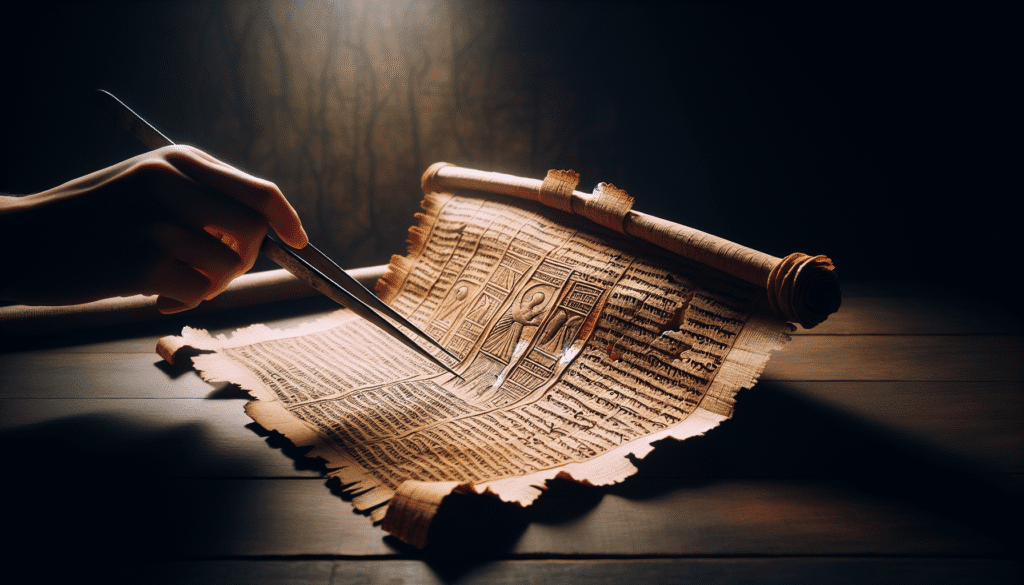Have you ever wondered about the oldest written records of the New Testament? Discover the fascinating story of the John Rylands Papyrus, often hailed as one of the earliest fragments of the Gospel of John. Authored by Dr. James Elliott, with a PhD in Theology, this article explores why this papyrus remains significant in 2025. In a time of ongoing debates about the roots and reliability of biblical texts, understanding such early fragments can offer a glimpse into the transmission of these influential writings through history.

TL;DR
The John Rylands Papyrus, also known as Papyrus P52, is considered the oldest known fragment of the New Testament, specifically the Gospel of John. It dates back to the first half of the 2nd century and resides in the John Rylands Library in Manchester, UK. This small fragment has profound implications for biblical scholarship, shedding light on the early circulation of Gospel texts and influencing views on the formation of the New Testament canon. In this guide, we explore its discovery, significance, and ongoing impact on theological studies and historical comprehension.
Understanding the John Rylands Papyrus
What is the John Rylands Papyrus?
The John Rylands Papyrus P52 is a small piece of papyrus containing a portion of the Gospel of John. This document, though small in size, has played a significant role in the scholarly understanding of early Christian texts. It contains text from John 18:31-33 on one side and text from John 18:37-38 on the other.
- Discovery and Acquisition: The papyrus was purchased in Egypt by Bernard Grenfell in 1920 and was acquired by the John Rylands Library in 1924. It was not until the 1930s that its significance was realized by Greek papyrologist C. H. Roberts.
- Dating the Fragment: Palaeographic analysis dates the fragment to the first half of the 2nd century, placing it remarkably close to the time of the original composition of the Gospel of John.

Why Is This Fragment Important?
In the realm of biblical studies, context is everything. The John Rylands Papyrus is crucial for several reasons. Firstly, it provides tangible evidence of the Gospel circulating within a few decades after its composition. It challenges earlier theories that the New Testament was first passed through oral tradition and demonstrates an existing written tradition.
- Implications for the Gospel of John: Its 2nd-century date supports the theory that the Gospel of John was written by the end of the 1st century AD, earlier than some skeptics propose.
- Early Christianity: The fragment suggests active Christian communities distributed texted materials, revealing a glimpse into early Christian life.
- Canon Formation: P52 underscores the early use and recognition of John’s Gospel, informing discussions about the canonization process.
The Journey of P52 to the John Rylands Library
How did this fragment end up in Manchester? The story of the John Rylands Papyrus indeed consists of several intriguing phases.
- Initial Finding: Discovered among other papyrus fragments in an Egyptian market, it initially seemed unremarkable.
- C. H. Roberts’ Analysis: Decades later, Roberts identified it as having text from the Gospel of John, instantly elevating its historical significance.
- Current Home: Today, it’s housed at the John Rylands Library, where enthusiasts and scholars flock to glimpse a piece of early Christian history.
Analyzing the Textual Content
While the fragment is small, it offers more than just its physical presence.
- Textual Variants: P52 shares textual similarities with later manuscripts, suggesting a stable transmission of the text, an invaluable piece of evidence for textual critics.
- Comparative Analysis: Comparing P52 with other ancient texts, such as the Codex Sinaiticus, enables scholars to trace textual variations and draw insights about early Gospel transmission.
What Does This Mean for Biblical Scholarship Today?
Fast forward to 2025, and you’ll find that this fragment is still a subject of scholarly intrigue and public fascination.
- Implications for Authenticity: Supporting the early dating of the Johannine text bolsters arguments for historical reliability in Christian scripture.
- Encouraging Dialogue: Continues to spark conversations about ancient manuscript traditions in academic and theological circles.
- Technology’s Role: Digital technologies have made it easier than ever to analyze and collaborate on ancient texts, enhancing our understanding of P52 and similar manuscripts.
FAQs About the John Rylands Papyrus
What is the John Rylands Papyrus?
The John Rylands Papyrus, also known as Papyrus P52, is the oldest known fragment of the New Testament, containing a portion of the Gospel of John dating to the early 2nd century.
How was P52 dated?
The papyrus was dated using palaeography, the study of ancient writing, comparing its script style to other datable texts from the same era.
Where is the John Rylands Papyrus housed?
It resides in the John Rylands Library in Manchester, UK, where it is part of a larger collection of historical manuscripts.
Why is P52 relevant today?
Aside from its historical value, P52 supports the authenticity and early transmission of the Gospel of John, influencing theological scholarship and its understanding of early Christianity.
Does P52 affect the understanding of the New Testament canon?
Yes, its existence suggests the Gospel of John was already recognized and widely disseminated by the early 2nd century, affecting views on the canonization process.
People Also Ask
How is the John Rylands Papyrus preserved?
The papyrus is well-preserved in a climate-controlled environment within the John Rylands Library to prevent deterioration.
What portion of the Gospel of John does the papyrus contain?
It contains parts of John 18:31-33 on one side and John 18:37-38 on the other.
Is P52 the only early New Testament fragment?
No, there are other early fragments, but P52 is notably the oldest dated fragment of the New Testament so far discovered.
Who discovered the significance of P52?
C. H. Roberts was the scholar who identified the text as part of the Gospel of John and recognized its significance in the 1930s.
What are textual variants?
Textual variants refer to differences between manuscripts. Studying these helps scholars understand the transmission and integrity of biblical texts.
As you continue reading, you’ll uncover the vast array of information surrounding this unassuming fragment. The journey of the John Rylands Papyrus from a discovery in Egypt to its place in modern scholarly debate is a testament to the enduring mystery and educational promise that ancient manuscripts provide, extending far beyond the realm of theology into the heart of history itself.




